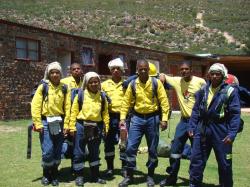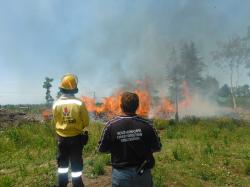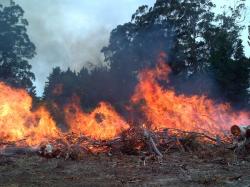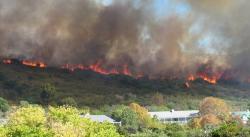Fire Safety
Some facts about fire and how to deal with it
What is fire?
- It is a chemical reaction in which organic substances are transformed into simpler inorganic compounds
-
The elements that must be present for a fire to occur are:
- oxygen
- heat
- fuel
Veldfires
- It is impossible to exclude oxygen from fires.
- Heat is considered a constant.
- However, a reduction in fuel will reduce the total energy output.
- Fuel is anything capable of burning and sustaining combustion in the present of oxygen when heat is applied to it.
Vegetation as fuel
- Shrubs and grasses.
- Bark, especially if it is loose, fibrous or stringy.
- Litter (dead leaves, twigs and bits of bark found on the ground).
Veldfire behaviour
- Veldfires all start small but their rate of spread and heat generated (intensity) depends on the weather, the terrain and the condition of the available fuel.
- The more intense the veldfire the more difficult it is to control.
Fire intensity
- I = H * w * R
Where:
- I = Intensity (kW/m)
- H = Heat (KJ/kg)
- w = Weight of fuel (tons/Ha)
- R = Rate of spread (km/hr)
The only aspect that can be influenced is the amount of fuel present.
Characteristics of veldfire
-
Veldfire will in general:
·spread faster uphill than downhill
·spread with the wind rather than against it
·spread faster where the vegetation contains quantities of dead plant material
·spread faster in fine fuels
·spread faster where the vegetation canopy is intertwined
Doubling the fuel load will double the rate of spread, resulting in the intensity of the fire increasing fourfold.
Examples of fire intensity
7.5 tons per hectare 300 kW/m 15 tons per hectare 1 300 kW/m 30 tons per hectare 5 200 kW/m
- Fuel levels of 7.5 tons per hectare are relatively easy to control.
- In fully cured (dried) grass, the flame height will be 2 metres.
Radiant heat
- This is the heat generated by a fire.
- This heat affects you well before the flames reach you.
- If you are not protected, radiant heat can kill you by causing heat stroke.
- Radiant heat only travels in straight lines.
What can you do to reduce your exposure to veldfire?
Some questions to ask yourself:
- Do you live in a veldfire-prone area?
- Have you identified and dealt with high fire risks around your property?
- How will you stay informed of fire conditions on high fire risk days?
- Do you have an adequate and reliable source of water?
- What assistance can you expect if there is a veldfire?
- If you decide to evacuate, what route will you use and what will you take with you?
- If you decide to stay, do you know how to protect yourself from radiant heat?
- Do you have appropriate clothes ready for everyone if decide to stay?
Where your house is located on your property is important
- Some parts of your property will be safer.
- Flat ground is safer.
- Gentle slopes are safer than steep slopes.
- The bottom of a slope is safer than the top of a slope.
- Properties situated next to dense vegetation and / or on ridges are at greater risk
Why do houses burn?
- Burning embers landing on or near the house.
- Radiant heat ahead of the fire.
- Direct contact from flames.
The main source of ignition in a house is burning embers.
- Houses do not have to be specially built to protect you from a fire.
- No one building feature will guarantee safety.
Fuel reduction
- Reducing fuel will reduce the threat.
- Reduce fuels ahead of the fire season.
- Reduce fuel for at least 20 metres around buildings
- Beware of ‘fingers’ of vegetation that penetrate your property.
Firebreaks
- Firebreaks are areas of reduced fuel allowing access of fire fighters and equipment to attack an oncoming fire.
- Do not rely on a firebreak to stop a veldfire.
- The effectiveness of a firebreak depends on its positioning and on regular maintenance.
Methods of preparing firebreaks
- Ploughing.
- Grazing.
- Mowing and slashing.
- Herbicides.
- Burning.
Incorporate existing features into firebreaks.
Landscaping a garden for fire protection
- Plant screening trees.
- Build stone walls as a radiant heat shield.
- Position lawns and other low fire risk features between houses and where a veldfire is most likely to approach from.
- Maintain green lawns, cultivated soils or gravelled areas beneath trees.
- Remove dead trees, branches and leaves.
- Prune lower branches to avoid continuous fuel from ground to tree canopy.
- Remove trees close to house or overhanging or touching a house.
- Ensure trees are a safe distance from buildings and power lines.
- Avoid dense clumps of trees and remove highly flammable trees.
- Maintain building protection zones around all buildings.
Veldfire survival plans
- Your plan should cover both staying and defending your property or leaving it ahead of the veldfire.
Staying?
- What actions will you take before the veldfire arrives?
- Where will you shelter when the fire front passes?
- What actions will you take after veldfire passes?
Leaving?
- Where will you go?
- How will you get there?
- What will you take?
- What will you do with your pets?
- When will you return?
- What will you do when you return?
Protecting farm livestock
- Plan to use fallow fields, well grazed fields or areas with bare ground.
- Where possible, have shade and water available for valuable stock, especially breeding stock.
- Protect your fodder reserves.
Preventing fires on a farm
- Remove branches that could cause power line short circuits and check electrical installations regularly.
- Restrict the use of farm machinery on days when the fire danger is high.
- Take great care when using welding, cutting and grinding equipment.
- Establish firebreaks between your land and roads or railways.
- Adopt safety standards for smoking, burning rubbish and disposal of hot ash.
- Make sure all fires are extinguished properly before leaving – never leave a fire unattended.
- Have your own well-maintained fire fighting equipment on a farm.
- Train your staff in firefighting techniques.
Stages of a veldfire
- Embers and smoke.
- Fire front.
- Final stage.
What you should do when veldfire approaches
- Make decisions early – carry out the planned response, that is, to evacuate or to stay?
- Dress in protective clothing.
- Move livestock to safer locations.
- Listen to radio for news.
- Wet garden and house especially on the side of the approaching fire.
- Plug gutters and fill them with water
- Fill baths, buckets and dust bins with water in case the water supply fails and have mops handy.
- Seal any gaps between doors and floor using wet towels or similar items.
- Close up the house and screen off the windows.
- If you decide to stay, go indoors when the fire arrives and remain there until the fire front has passed.
- Take fire hoses and other fire fighting equipment indoors with you.
- Patrol the house interior including checking the roof cavity and extinguish any small fires immediately.
- Remain vigilant after the fire front has passed.
Useful fire fighting equipment
- Hoses.
- A water pump – petrol or diesel (electricity supply may be disrupted during a fire).
- Ladders.
- Fire beaters, rake-hoes and shovels.
- Torch plus spare batteries.
- Protective woollen blanket.
- Towels.
- Buckets (preferably metal) and mops.
- Knapsack spray.
- Suitable protective clothing.
- Gloves.
- Sturdy boots or shoes and woollen socks.
- Hat with a wide brim.
- Goggles to protect eyes from smoke.
- Long sleeved shirts and trousers.
- Large handkerchiefs to cover nose and mouth.
- Wet towels for neck.
- Water bottles.
NB: All protective clothing should be made of natural fibres.
Checklist of steps to be taken before the fire season
On your perimeter:
- reduce fuel loads
- pay special attention to fuel load management in down-slope areas
- construct firebreaks adjacent to the property.
Building maintenance:
- clear leaves and debris from gutters
- secure any loose roof tiles
- remove inflammable and dry vegetation from under decks and against walls and pillars
- seal roof vents, eaves and floor vents with wire gauze screening
- check that hoses are long enough to reach all sides of the house
- consider removing branches or trees that overhang buildings.
Garden maintenance:
- slash long grass and undergrowth
- remove dead and dry branches from trees.
Water supplies:
- ensure that your water supply while be sufficient and reliable in the event of a veldfire
- consider the placement of garden taps
- install a sprinkler system in your garden and on your roof.
Equipment:
- consider acquiring portable petrol powered pumps in addition to any electric pumps. electricity supplies can fail during a veldfire, rendering the pump useless
- check that all your fire fighting equipment is in working order
- install hose fittings that are fire-proof.
Livestock:
- prepare and maintain fuel-reduced areas into which livestock can be moved in a veldfire
Checklist of steps to be taken during the fire season
Early warning systems:
- be aware of weather conditions associated with high fire danger in your region (temperature, wind speed, direction and relative humidity)
- be aware of the daily fire danger rating during the fire season
- know what radio station will carry news of veldfires.
Communications:
- compile a list of phone numbers you may need during a veldfire
- make sure your property can be easily located by the fire brigade.
Buildings:
- remove hanging baskets with dry material from the building
- check gutters and roof comers for the accumulation of leaves
- remove inflammable materials such as woodpiles that are in close proximity to buildings
- store fuels and paints in a single place away from the house.
Garden:
- keep lawns short and green
- cut grass and other vegetation under screening trees
- remove dead leaves and dry vegetation and litter from the garden.
Water supplies:
- check water levels in reservoirs and water tanks daily when the fire danger is high
- attach hoses to taps when the fire danger is high.
Equipment:
- store fire beaters, rakes, spades, buckets, hoses, mops and other fire fighting equipment in a single easily accessible place
- check pumps on a daily basis when fire danger is high.
Survival plan:
- rehearse family emergency plan evacuation plan
- include your pets in your evacuation plan
- ensure that all your family members and staff know about how to stop, drop and roll if their clothing catches fire
- establish a safe meeting place for your family outside your house
- store protective clothing for the entire family in one easily accessible place
- ensure that sufficient drinking water is available.
Associated Files:
How to prepare you for a wild fireAPPROACHING a fire
PREPARING for a fire
PREVENTING a fire
Offences and Penalties
Living with Fire - Sustaining ecosystems & livelihoods through Integrated Fire Management
Hot on the trail of solutions to the threat of wildfire
Reels wat jou lewe kan red





